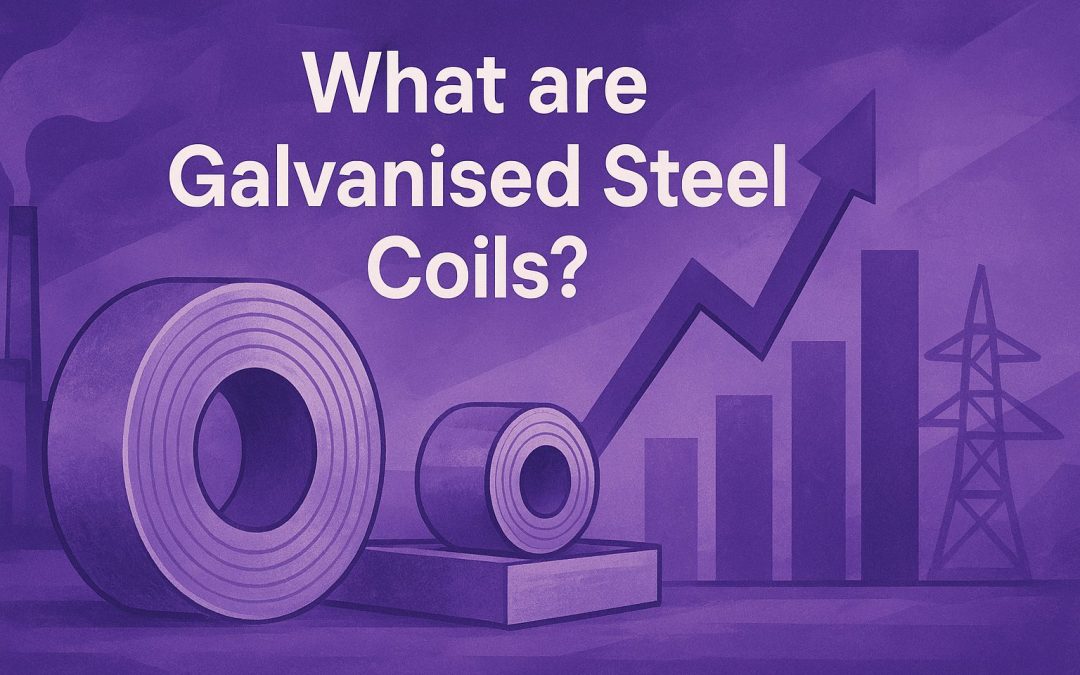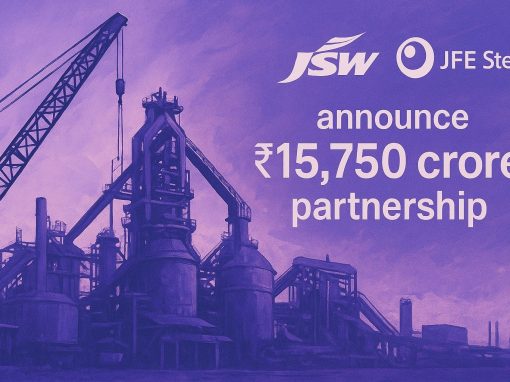Table of Contents
You must have heard the term galvanised steel coil. However, have you ever wondered what exactly galvanised steel coils are? What is their use? Let us dive into the meaning of galvanised steel, methods of galvanising, and the benefits and applications of galvanised coils.
Also read: What is galvanised steel?
What are Galvanised Steel Coils?
Galvanised steel coils (GI coils) are among the most widely used steel products in the manufacturing, automotive, and construction sectors due to their superior corrosion resistance and cost-efficiency. These coils are made by applying a protective zinc coating to steel, enhancing its durability and performance in harsh environments. Galvanised steel is available in various grades, thicknesses, and standards (such as IS 277 and ASTM A653) to meet diverse industrial needs. Whether used for roofing sheets, automotive panels, or industrial tanks, galvanised steel coils offer an ideal combination of strength and longevity.
For buyers and procurement teams, choosing the right galvanised steel coil involves evaluating coating type, grade, and supplier reliability. In this article, we explore the benefits, methods, and key applications of galvanised steel coils to help you make informed sourcing decisions.
Benefits of Galvanised Steel Coils
Galvanised steel coils offer multiple advantages that make them a preferred material across industries such as construction, automotive, and manufacturing. The zinc coating provides superior corrosion resistance and ensures long-lasting performance even in harsh environments. Below are the key benefits:
Superior Corrosion Resistance:
The zinc coating acts as a protective barrier that prevents rust formation and shields the steel surface from moisture, oxygen, and chemical exposure. This makes galvanised steel suitable for both indoor and outdoor use.
Extended Service Life
With enhanced resistance to corrosion and weathering, galvanised steel offers longer durability and longevity, reducing the frequency of replacements and downtime in operations.
Low-maintenance and Reliable:
Galvanised steel is known as maintenance-free steel, as it requires minimal upkeep after installation. The protective layer remains effective for years without frequent painting or coating.
Cost-efficient Protection:
While the initial cost may be higher than plain steel, galvanised steel offers significant savings in the long run due to reduced repair, maintenance, and replacement expenses.
Mechanical Strength and Toughness:
The galvanised coating provides additional impact resistance and protects steel components from mechanical damage during handling, transport, and installation.
All-weather Performance:
Galvanised steel coils perform reliably under extreme weather conditions, maintaining strength and appearance in humid, coastal, or industrial environments.
In short, galvanised steel combines durability, protection, and cost-effectiveness, making it a smart choice for applications requiring long-term performance and minimal maintenance.
Applications of Galvanised Steel Coils
Galvanised steel coils are versatile and used across a wide range of industries due to their strength, corrosion resistance, and cost efficiency. Below are some of the most common industrial applications of galvanised steel, categorized by sector.
Construction Uses
- Galvanised steel is a staple material in the construction industry because of its durability and resistance to rust.
- Used in roofing sheets, wall cladding, and structural frames for buildings.
- Common in balconies, staircases, guardrails, and fences, providing both strength and aesthetic appeal.
- Serves as a protective layer for ridges, valleys, and gutters in roofing systems.
- Ideal for infrastructure projects such as bridges, street furniture, and highway barriers exposed to weather conditions.
Automotive Uses
- In the automotive sector, galvanised steel coils help manufacturers enhance vehicle safety and longevity.
- Used to make body panels, underbody components, bumpers, and chassis parts due to their corrosion-resistant properties.
- Electro-galvanised steel is often chosen for components requiring smooth finishes, such as doors and hoods.
- Extends vehicle lifespan and reduces maintenance costs associated with rust and wear.
Electrical and HVAC Applications
- Galvanised steel is also used extensively in electrical and HVAC systems where durability and conductivity are key.
- Used for electrical enclosures, cable trays, and switchgear panels.
- Commonly used in ducting, ventilation pipes, and HVAC casings, where moisture resistance is essential.
- Offers safety and compliance with industrial standards for electrical and air distribution systems.
Industrial Tanks & Storage
- In industrial and manufacturing facilities, galvanised steel plays a crucial role in safe storage and processing.
- Used for storage tanks, silos, bins, and water containers, especially for non-corrosive materials.
- Preferred in chemical, agricultural, and water treatment plants due to its ability to withstand exposure to humidity and chemicals.
- Ensures long-term, low-maintenance performance even in demanding industrial environments.
Other Applications
Beyond these major industries, galvanised steel coils are used in:
- Appliances (e.g., washing machine panels, refrigerators).
- Agriculture equipment (e.g., sheds, grain silos, irrigation systems).
- Marine and coastal infrastructure where resistance to saltwater corrosion is critical.
Methods of Galvanising Steel Coils
There are several methods used to galvanise steel coils, each offering different coating properties, surface finishes, and ideal applications. The table below compares the most common galvanising techniques and their industrial relevance.
| Method | Process Description | Coating Characteristics/ Quality | Ideal Applications & End-use Industries |
| Hot-dipped Galvanising | Steel is immersed in molten zinc at high temperatures, forming a thick, metallurgically bonded zinc coating. | Produces a thick, durable coating with excellent corrosion resistance and a slightly rough surface texture. | Best suited for construction, infrastructure, and outdoor structural components such as guardrails, roofing sheets, and beams exposed to weather. |
| Galvanealing | Combines hot-dipping with annealing – steel is dipped in molten zinc and then heat-treated to create a matte grey finish. | Results in a zinc-iron alloy coating with superior paintability and surface adhesion. | Common in automotive manufacturing and appliance fabrication where a smooth, paint-ready surface is needed. |
| Pre-Galvanising (Mill Galvanising) | Performed in steel mills before fabrication – the steel sheet is passed through molten zinc and recoiled immediately. | Offers uniform coating thickness and quick production. Coating is thinner than hot-dipped. | Suitable for light fabrication, ducting, and indoor applications where less corrosion exposure is expected. |
| Electrogalvanising | Uses an electrolytic process to coat steel with a controlled layer of zinc without immersion in molten zinc. | Produces a thin, smooth, and precise coating with excellent surface finish but lower corrosion resistance than hot-dipped. | Ideal for automotive panels, electronic housings, and consumer appliances requiring smooth aesthetics and precision. |
| Galvanising of Advanced High-Strength Steel (AHSS) | Involves dipping AHSS in molten zinc with controlled chemical treatment for improved adhesion and strength. | Ensures high-strength, formable coating with enhanced bonding and durability. | Used in automotive body structures, safety components, and industrial machinery that require both strength and corrosion resistance. |
Also Read on:
Aluminium Coil, Hot rolled steel coil, Colour coated steel coil, Stainless steel coil.
Looking to procure steel?
Tata nexarc helps manufacturers, builders and MSMEs source certified steel products, compare prices, and choose the right grade as per IS codes—with complete traceability and procurement confidence.
FAQs
What are galvanised steel coils?
Why are galvanised steel coils used?
What are the main benefits of galvanised steel coils?
What are the types of galvanising methods?
How long do galvanised steel coils last?
What industries commonly use galvanised steel coils?
How do galvanised steel coils differ from plain steel coils?
Are galvanised steel coils suitable for outdoor use?
Can galvanised steel be painted or welded?
Where can I buy galvanised steel coils?
Swati is a passionate content writer with more than 10 years of experience crafting content for the business and manufacturing sectors, and helping MSMEs (Micro, Small and Medium Enterprises) navigate complexities in steel procurement, and business services. Her clear and informative writing empowers MSMEs to make informed decisions and thrive in the competitive landscape.






